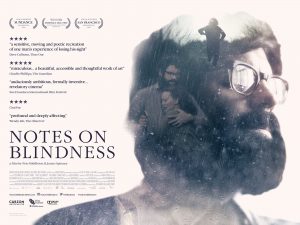 How do you communicate to a seeing audience the experience of losing sight using the medium of video? Notes on Blindness makes a fantastic and memorable attempt at the impossible. John Hull went blind after a series of eye operations, finally losing his sight at the age of 45. He recorded his comments on what adult-onset blindness is like between 1983 and 1986, three years after the last eye operation in 1980. Actors perform brilliantly to a sound track comprising extracts from John Hull’s original tapes and extracts from some more recent recordings by him and his wife. (John Hull died in 2017.) So the star of this film is John Hull’s voice, as he reports from a blind ‘perspective’. The transcripts of the original recordings were published originally as Touching The Rock in 1990, and republished as Notes on Blindness to coincide with this documentary.
How do you communicate to a seeing audience the experience of losing sight using the medium of video? Notes on Blindness makes a fantastic and memorable attempt at the impossible. John Hull went blind after a series of eye operations, finally losing his sight at the age of 45. He recorded his comments on what adult-onset blindness is like between 1983 and 1986, three years after the last eye operation in 1980. Actors perform brilliantly to a sound track comprising extracts from John Hull’s original tapes and extracts from some more recent recordings by him and his wife. (John Hull died in 2017.) So the star of this film is John Hull’s voice, as he reports from a blind ‘perspective’. The transcripts of the original recordings were published originally as Touching The Rock in 1990, and republished as Notes on Blindness to coincide with this documentary.
The director uses several strategies to fill the visual presence which is demanded by video (and which is not required by a book). Fingers feeling for tapes and for the controls of a cassette recorder recur, since this was Hull’s means of communication and of maintaining his working life. There are a lot of blurred images of actors playing Hull’s children, and dark shots of a hand feeling its way around furniture or a room. We see the actor playing Hull walking through Birmingham University buildings using a white stick. He is also seen in the very different environment of Australia – Hull made one difficult visit back to his family and the birthplace that he knew from the time previous to his loss of sight. There is special treatment for John Hull’s ‘observation’ that rain creates an auditory world of contours and space as it lands on the various objects in an environment, and his wish for something similar indoors is accompanied by shots of rain falling on an indoor world, a chair and objects in a room. Unforgettable matching of words and image.
Some of the most vivid images in the film illustrate the dreams that John Hull continued to experience for years after losing his sight – dreams that often featured his children, or environments that highlighted his anxieties about blindness. In the film the vivid nature of these sequences make it clear that these are dreams. In the book the dreams are sometimes described without context, and it only slowly becomes apparent that Hull is recalling a dream, and perhaps that uncertainty is sometimes a characteristic of our dream world.
This is a magnificent documentary, ending with a shot of John Hull and his wife standing facing the ocean and listening to the oncoming waves. It repays repeated viewings.
Notes on Blindness, Broadcast on Storyville, BBC4, 21:00 16/02/2017, 80 mins. Director Peter Middleton
Available on bob (education video database)
https://learningonscreen.ac.uk/ondemand/index.php/prog/0E5E925D (Accessed 25 Mar 2018) (username & password required)